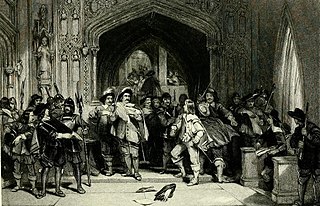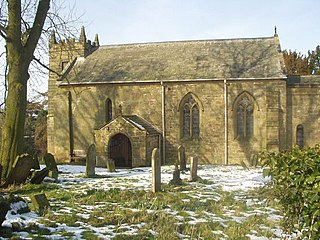Related Research Articles

1660 (MDCLX) was a leap year starting on Thursday of the Gregorian calendar and a leap year starting on Sunday of the Julian calendar, the 1660th year of the Common Era (CE) and Anno Domini (AD) designations, the 660th year of the 2nd millennium, the 60th year of the 17th century, and the 1st year of the 1660s decade. As of the start of 1660, the Gregorian calendar was 10 days ahead of the Julian calendar, which remained in localized use until 1923.

Charles II was King of Scotland from 1649 until 1651 and King of England, Scotland, and Ireland from the 1660 Restoration of the monarchy until his death in 1685.

The Restoration of the Stuart monarchy in the kingdoms of England, Scotland, and Ireland took place in 1660 when King Charles II returned from exile in continental Europe. The preceding period of the Protectorate and the civil wars came to be known as the Interregnum (1649–1660).

George Monck, 1st Duke of Albemarle KG PC JP was an English soldier, who fought on both sides during the Wars of the Three Kingdoms. A prominent military figure under the Commonwealth, his support was crucial to the Restoration of Charles II in 1660, who rewarded him with the title Duke of Albemarle and other senior positions.

Colonel Thomas Pride was a Parliamentarian commander during the Wars of the Three Kingdoms, best known as one of the regicides of Charles I and as the instigator of Pride's Purge.
This article contains information about the literary events and publications of 1660.

The Wars of the Three Kingdoms, sometimes known as the British Civil Wars, were a series of intertwined conflicts fought between 1639 and 1653 in the kingdoms of England, Scotland and Ireland, then separate entities united in a personal union under Charles I. They include the 1639 to 1640 Bishops' Wars, the First and Second English Civil Wars, the Irish Confederate Wars, the Cromwellian conquest of Ireland and the Anglo-Scottish War of 1650–1652. They resulted in victory for the Parliamentarian army, the execution of Charles I, the abolition of monarchy, and founding of the Commonwealth of England, a unitary state which controlled the British Isles until the Stuart Restoration in 1660.

Colonel Adrian Scrope, also spelt Scroope, 12 January 1601 to 17 October 1660, was a Parliamentarian soldier during the Wars of the Three Kingdoms, and one of those who signed the death warrant for Charles I in January 1649. Despite being promised immunity after the Restoration in 1660, he was condemned as a regicide and executed in October.

John Jones Maesygarnedd was a Welsh military leader and politician, known as one of the regicides of King Charles I following the English Civil War. A brother-in-law of Oliver Cromwell, Jones was a Parliamentarian and an avid republican at a time when most of Wales was Royalist, and became one of 57 commissioners that signed the death warrant authorising the execution of Charles I following his trial. After the Restoration of the monarchy, Jones was one of few excluded from the general amnesty in the Indemnity and Oblivion Act, and was tried, found guilty, then hanged, drawn and quartered at Charing Cross.
Colonel Sir Richard Ingoldsby was an English officer in the New Model Army during the English Civil War and a politician who sat in the House of Commons variously between 1647 and 1685. As a Commissioner (Judge) at the trial of King Charles I, he signed the king's death warrant but was one of the few regicides to be pardoned.
Henry Cary, 4th Viscount Falkland was an English politician who sat in the House of Commons between 1659 and 1663.

Sir Allen Apsley was an English landowner who was a Royalist soldier and administrator during the Wars of the Three Kingdoms. Following the 1660 Stuart Restoration, he took part in the Second Anglo-Dutch War, and sat as MP for Thetford from 1661 to 1679. One biographer describes him as having an "ability to maintain friendly contact with figures across a wide range of affiliations, which helped to make him a successful political fixer".

Lisle's Tennis Court was a building off Portugal Street in Lincoln's Inn Fields in London. Originally built as a real tennis court, it was used as a playhouse during two periods, 1661–1674 and 1695–1705. During the early period, the theatre was called Lincoln's Inn Fields Playhouse, also known as The Duke's Playhouse, The New Theatre or The Opera. The building was rebuilt in 1714, and used again as a theatre for a third period, 1714–1732. The tennis court theatre was the first public playhouse in London to feature the moveable scenery that would become a standard feature of Restoration theatres.

Francis Lascelles (1612-1667), also spelt Lassels, was an English politician, soldier and businessman who fought for Parliament in the 1639-1652 Wars of the Three Kingdoms and was a Member of Parliament between 1645 and 1660.

George Fleetwood (1623–1672) was an English major-general and one of the regicides of King Charles I of England.
Matthew Thomlinson (1617–1681) was an English soldier who fought for Parliament in the English Civil War. He was a regicide of Charles I. Tomlinson was a colonel of horse (cavalry) in the New Model Army and was one of the officers presenting the remonstrance to parliament in 1647. He took charge of Charles I in 1648, until Charles's execution, but refused to be his judge. He followed Oliver Cromwell to Scotland in 1650.

The Restoration of the monarchy began in 1660. The Commonwealth of England, Scotland and Ireland (1649–1660) resulted from the Wars of the Three Kingdoms but collapsed in 1659. Politicians such as General Monck tried to ensure a peaceful transition of government from the "Commonwealth" republic back to monarchy. From 1 May 1660 the English, Scottish and Irish monarchies were all restored under King Charles II. The term Restoration may apply both to the actual event by which the monarchy was restored, and to the period immediately before and after the event.
The Governor of Pendennis Castle was a military officer who commanded the fortifications at Pendennis Castle, part of the defences of the River Fal and Carrick Roads, on the south coast of Cornwall near Falmouth. Originally fortified under Henry VIII, defences in the area were intermittently maintained until after the Second World War. The office of governor was abolished in 1837, when Gen. Anderson received the colonelcy of the 78th Regiment of Foot.

The rank of general at sea, was the highest position of command in the English Parliamentary Navy, and approximates to the current rank of admiral. Alongside others, the generals at sea were also appointed as Commissioners for the Admiralty and Navy.
Henry Norwood, of Bishampton, Worcestershire supported the Royalist cause in the English Civil War as a distinguished cavalry officer fighting as a volunteer at Bristol and Worcester. After the defeat, trial and execution of Charles I, he set out on what proved to be a difficult journey to Virginia, where a cousin was governor. He returned to England, became active as an agent attempting to aid Royalist uprisings, and spent a significant time imprisoned in the Tower for his pro-Royalist activities. Upon his release he was involved in Booth's Uprising and, subsequently, acted as a messenger between Charles II of England and Edward Montagu, Earl of Sandwich. He was appointed deputy governor in Dunkirk a little after the Restoration and, when Dunkirk was sold to Louis XIV of France, he was sent to Tangier, where he rose to become governor. He was a Member (MP) of the Parliament of England for Gloucester 20 April 1675. He died in Leckhampton in 1689, and was buried in St Peter's Church, Leckhampton.
References
- ↑ "January 1". Chambers' Book of Days. Archived from the original on 17 December 2007. Retrieved 2007-12-09.
- 1 2 Keay, Anna (April 2022). "The maid who restored the monarchy". History Today . 72 (4): 64–9.
- 1 2 3 4 5 Penguin Pocket On This Day. Penguin Reference Library. 2006. ISBN 0-14-102715-0.
- 1 2 3 4 5 6 Palmer, Alan; Palmer, Veronica (1992). The Chronology of British History. London: Century Ltd. pp. 187–188. ISBN 0-7126-5616-2.
- 1 2 3 4 5 "The Convention Parliament". British Civil Wars, Commonwealth and Protectorate. 2007-06-16. Archived from the original on 2012-08-22. Retrieved 2012-10-24.
- ↑ Greaves, Richard L. (1986). Deliver Us From Evil: the radical underground in Britain, 1660-1663. Oxford University Press. pp. 27–29. ISBN 0-19-503985-8.
- ↑ Macaulay, Thomas Babington. History of England. pp. 109–110.
- ↑ "Friday 25 May 1660". The Diary of Samuel Pepys. Retrieved 2011-08-24.
- ↑ Allan, Marshall (2003). Intelligence and Espionage in the Reign of Charles II, 1660–1685. Cambridge University Press. p. 79. ISBN 0-521-43180-8 . Retrieved 24 August 2011.
- ↑ Quintrell, Brian (2004). "Juxon, William (bap. 1582, d. 1663)" . Oxford Dictionary of National Biography (online ed.). Oxford University Press. doi:10.1093/ref:odnb/15179 . Retrieved 2011-08-24.(Subscription or UK public library membership required.)
- ↑ Groom, Nick (2007). The Union Jack: the story of the British Flag (Paperback ed.). London: Atlantic Books. pp. 150–1. ISBN 978-1-84354-337-4.
- ↑ The Hutchinson Factfinder. Helicon. 1999. ISBN 1-85986-000-1.
- ↑ Howe, Elizabeth (1992). The First English Actresses: Women and Drama, 1660–1700 . Cambridge University Press. p. 24.
- ↑ Gilder, Rosamond (1931). Enter the Actress: The First Women in the Theatre. Boston: Houghton Mifflin. p. 166.